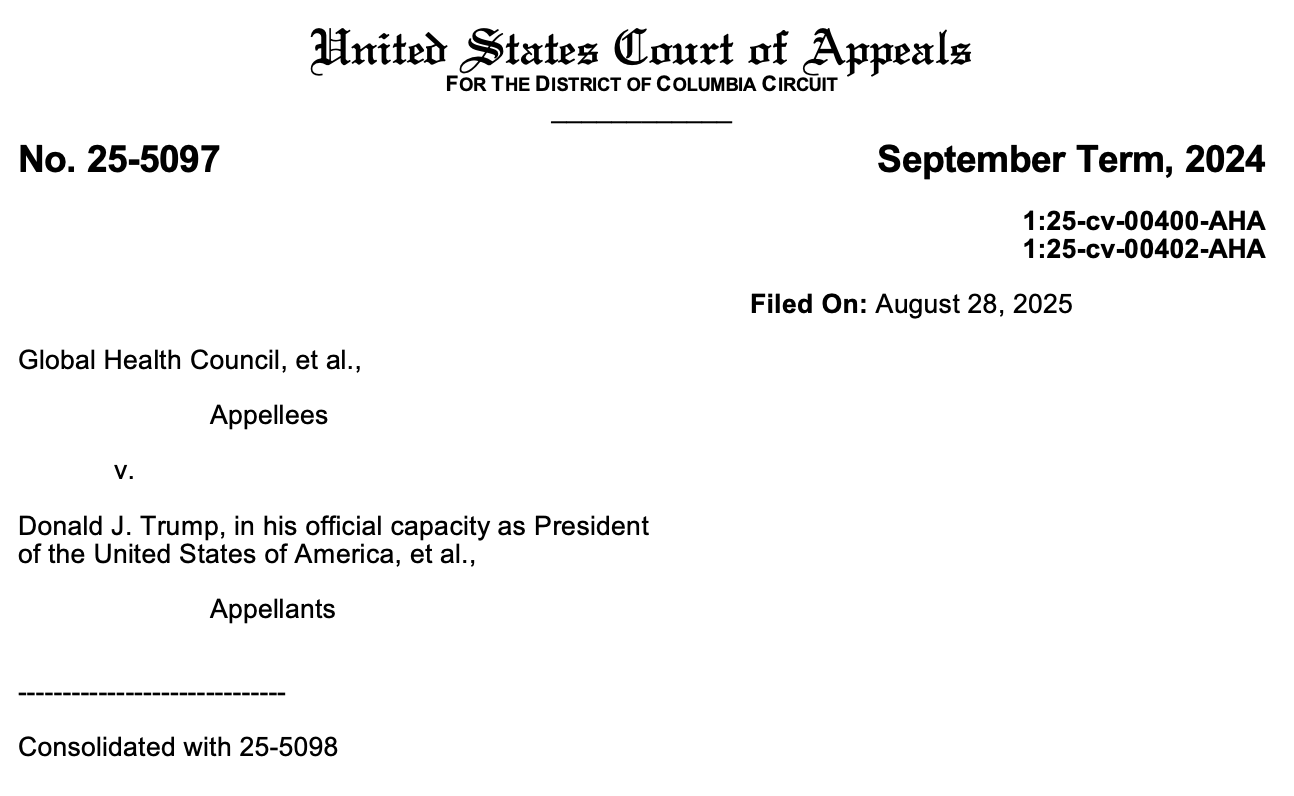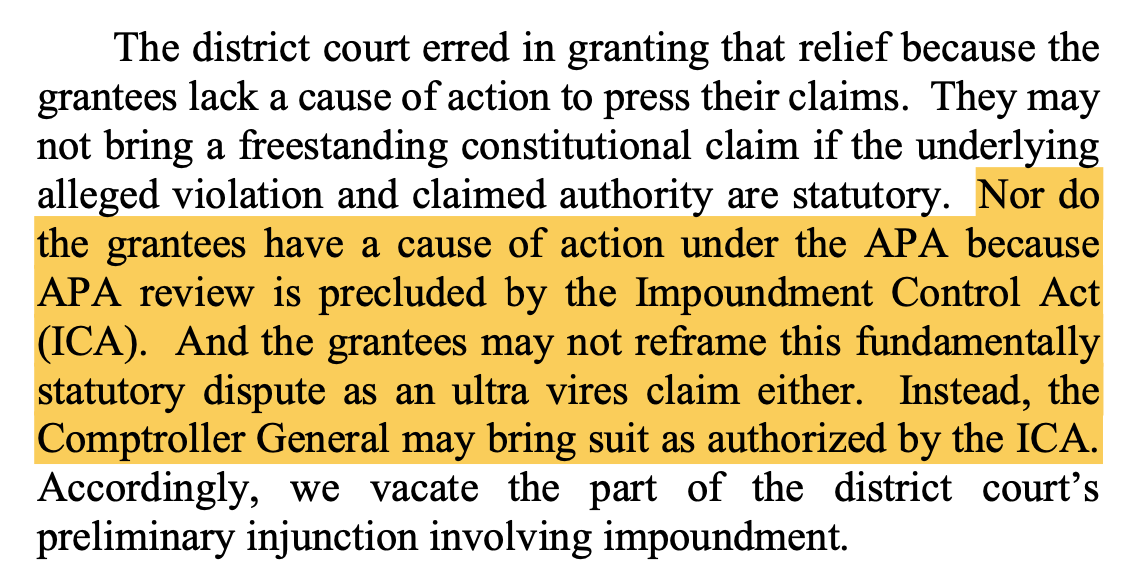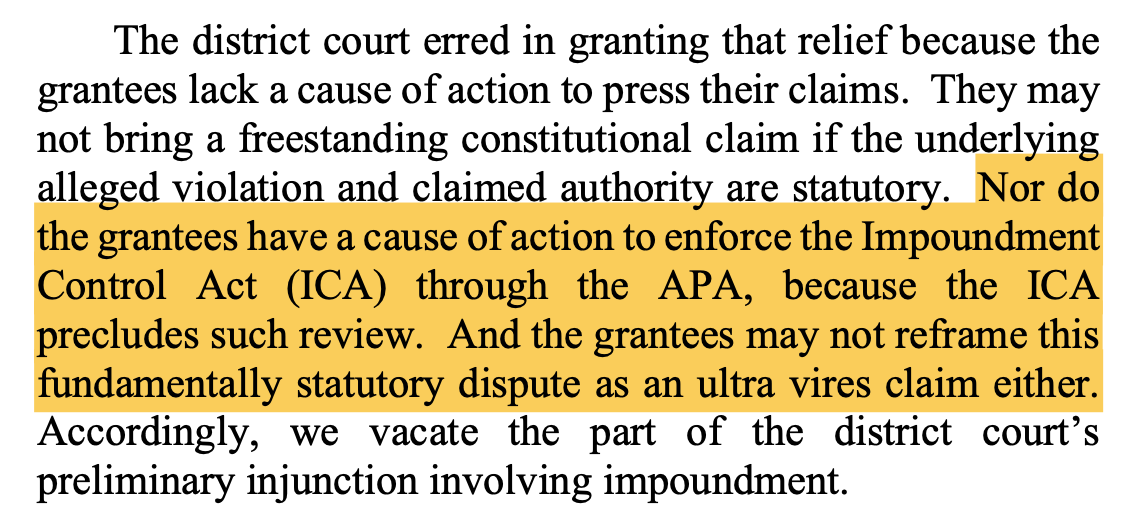The D.C. Circuit's realpolitik orders in the foreign aid funding case
What happened? Law Dork digs in.
A federal appeals court on Thursday evening took steps that Democratic appointees wrote could represent that best possible way of helping organizations funded by foreign aid payments to get money before a quickly approaching September 30 deadline.
It was the latest unusual sets of rulings in a case challenging the Trump administration’s efforts to cut foreign aid funding — raising the “impoundment” question about the president’s ability not to spend money that Congress has, with its control over appropriations, directed the federal government to spend — that has been up to the U.S. Supreme Court already twice this year.
On Thursday evening over the course of 30 minutes, the U.S. Court of Appeals for the D.C. Circuit took seven actions that ultimately sent the case — technically, a pair of cases — back to the district court, where it is before U.S. District Judge Amir Ali.
It was a stark sign of where we’re at: Judges on the court generally thought of as second only to the Supreme Court taking strategic steps to try to protect people and organizations’ rights due to the ways other branches — and actors within their own branch — are failing to do so.
What is the background?
Ali, a Biden appointee, had entered a preliminary injunction in the case in March, ordering the administration to take steps to “make available” the full amount of foreign aid funds appropriated. The Trump administration appealed and, on August 13, a three-judge panel issued a 2-1 decision holding that the organizational challengers couldn’t bring the lawsuit they brought — either on constitutional (separation of powers) or statutory (Administrative Procedure Act) grounds. This is a huge deal, and a very bad ruling for those seeking to hold the Trump administration accountable. Because the two judges in the majority were two of the four Republican appointees on the 11-judge court, the organizations, two days later, sought en banc review from the full court.
In the days that followed, however, the were several bumps in the road for the challengers.
First bump: Judge J. Michelle Childs, a Biden appointee, recused herself from consideration in the case, making the en banc court a four Republican appointee-six Democratic appointee split. All of the Democratic appointees participating would have to vote for the full court to rehear the case.
Second bump: At the district court level, on the same day the challengers sought en banc review at the D.C. Circuit, DOJ asked Ali to partially stay his injunction.
Third bump: After the D.C. Circuit made clear Ali’s injunction remained in effect while the full court considered whether to hear the matter en banc and Ali rejected DOJ’s request to partially stay the injunction, Solicitor General John Sauer — Donald Trump’s former personal attorney — went to the Supreme Court, asking the justices to block Ali’s injunction.
With all of that in mind, here is what happened at the D.C. Circuit on Thursday.
What was the amended panel opinion?
The panel — Judges Karen Henderson (George H.W. Bush) and Gregory Katsas (Trump) in the majority and Judge Florence Pan (Biden) dissenting — in a 6:57 p.m. order amended its opinion, “on the court’s own motion“ (meaning, by the panel). There was no major realignment or anything like that. Instead, one portion of the ruling — regarding the statutory APA claim — was clarified to make clear the appeals court decision was only ruling to limit the availability for the challengers to enforce the Impoundment Control Act through the APA.
So, this:
Became this:
In a new portion of a footnote in her dissent, Pan explained why this mattered:
The ICA is out, per the panel, but “the majority leaves open” APA claims based on the Appropriations Act itself on remand.
Along with the amended opinion, an amended judgement was issued by the D.C. Circuit, vacating the impoundment portion of the preliminary injunction and remanding the case to Ali for further proceedings in light of the amended opinion.
What did the full D.C. Circuit do?
In light of those changes, the full court — the 10 judges voting — denied the challengers’ request for en banc review. “[A] majority of the judges eligible to participate did not vote in favor of the petition,“ the court stated, per a 7:11 p.m. order.
The Democratic appointees to write on Thursday, however, explained this as a strategic move.
Judge Brad Garcia, a Biden appointee, wrote “respecting” the denial, “[T]he panel has revised its opinion in a way that allows [the Appropriations Act-based APA] claim to proceed. That claim (and any other remaining claims) may be litigated expeditiously in the district court. Granting en banc review of the distinct question whether the plaintiffs’ constitutional claim is viable would serve primarily to delay resolution of the plaintiffs’ statutory claim.“ In other words, this is the path that will move the case forward toward the possibility of relief for the challengers before the current appropriations expire on September 30. He also noted, as to the panel’s decision on the constitutional challenge question, “A similar question in a future case may warrant the Court’s en banc review.”
Garcia was joined in his two-paragraph statement by Judge Patricia Millett, an Obama appointee.
Pan dissented, expanding on her panel dissent and writing that the panel decision on the separation of powers constitutional question was inconsistent with past D.C. Circuit rulings, “creates a circuit split,” and “lets the Executive evade constitutional review“ under the panel’s reasoning. Because of that, she continued, “In my view, these are exceptionally important issues that warrant en banc reconsideration.“
For our purposes here, however, I want to highlight where Pan went in a second part of her dissent. “Although the full court’s decision not to rehear that issue is a mistake, there are some silver linings,” she wrote.
Echoing Garcia’s statement, Pan explained, “An immediate remand for the grantees to litigate claims that the Executive violated the Appropriations Act under the APA or acted ultra vires vis- à-vis the Appropriations Act” — citing to the footnote of her dissent I noted above — “may be the most efficient way for the grantees to seek access to the $15 billion of appropriated funds that are set to expire on September 30.” She also — albeit more aggressively than Garcia — noted the possibility of later en banc review. “[B]ecause the … issue will likely recur, our en banc court may have another opportunity to correct the panel opinion’s erroneous reasoning.” Should that happen, she continued, “we should take the first opportunity to revisit and correct the mistake that the court has made.“
Finally, Pan noted one other strategic advantage for the challengers of the Thursday moves:
Our denial of en banc review moots the government’s pending motion that asks the Supreme Court to stay the district court’s preliminary injunction pending this court’s completion of the en banc review process. If we had granted the petition for rehearing en banc and if the Supreme Court had granted a stay of the preliminary injunction, there might have been a significant gap in time with no operative order requiring the government to obligate the funds in question. But now, with an immediate remand, the grantees may well secure relief more quickly by pursuing a new preliminary injunction based on their APA or ultra vires claims before the district court.
So, Pan dissented — but she also explained how the vote that she disagreed with takes away the case from the Supreme Court, ends the appeal at the D.C. Circuit, and sends the case back to Ali.
What else was going on?
It is important to look at the politics and strategy likely involved here.1
The panel — two Republican appointees in the majority and a Democratic appointee in dissent — agreed to make those changes to the opinions. All three needed to agree to the changes for this to have happened this way.
That, in turn, likely came about due to pressure — directly or indirectly — from the Democratic appointees in the course of the en banc consideration.
And, as a further sign of the likely delicate negotiations that went on here, while going along with the changes to the panel opinion, Katsas did write a two-paragraph opinion concurring in the denial of the en banc rehearing — in other words, defending the panel opinion — that challenged two of Pan’s points in her dissent to the denial of en banc review.
In short, a lot happened behind the scenes in recent days — with varying levels of subtle compromise among George H.W. Bush, Obama, Trump, and Biden appointees — to get to Thursday’s orders.
And, finally, in a 7:18 p.m. order, the mandate was issued, sending the case back to Ali, and giving the organizations another opportunity to press for relief before the September 30 deadline.
This section was added shortly after publication, with the final update at 12:45 a.m. August 29.







Fascinating. Thank you for the explanation.
Wow. 4-dimensional chess to prevent SCOTUS from enabling folks who can't even play checkers from seizing lawfully appropriated funds.